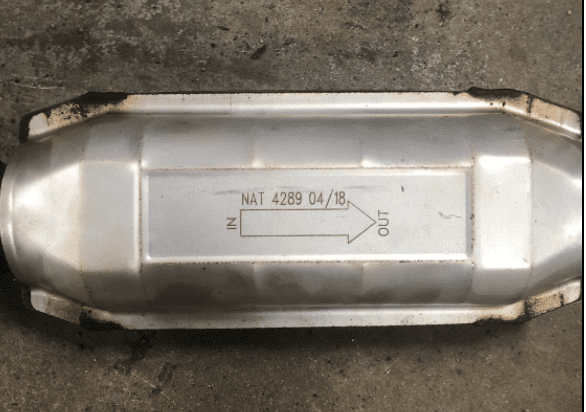In the realm of automotive repair and maintenance, the catalytic converter plays a crucial role. It reducing harmful emissions from a vehicle’s exhaust system. However, the market is flood with aftermarket options. That may not meet the same quality standards as their original counterparts. So, how can you tell if a catalytic converter is aftermarket? In this guide, we will explore the subtle yet telling differences between original and aftermarket catalytic converters. Equipping you with the knowledge to make informed decisions when it comes to your vehicle’s emission control system.
Firstly, it is essential to understand the basics of a catalytic converter. This emission control device has main components: the catalyst, the housing, and the substrate. Original catalytic converters are manufacture the vehicle’s original equipment (OEM) and are designed to meet specific performance. On the other hand, third-party produce aftermarket catalytic converters and may not adhere to the same stringent standards. By examining the construction and materials used in a catalytic converter, along with other distinguishing features, you can determine whether it is an aftermarket product or an original component. So, let us delve into the telltale signs that will enable you to identify whether a catalytic converter is aftermarket or not.
How to tell if a catalytic converter is aftermarket:
- Inspect the label: Look for any markings or labels on the catalytic converter that indicate it is aftermarket.
- Check the size and shape: Aftermarket catalytic converters may have different dimensions or shapes compared to the original equipment.
- Examine the welding: Poor welding quality or visible signs of modification can suggest an aftermarket converter.
- Compare with OEM specifications: Research the original equipment manufacturer (OEM) specifications for your vehicle’s catalytic converter and compare it with the one installed.
- Consult a professional: If you are unsure, it is always best to seek the assistance of a qualified mechanic or automotive expert.
 Source:
Source:
How to Tell if a Catalytic Converter is Aftermarket
A catalytic converter is an essential component of a vehicle’s exhaust system. It helps reduce harmful emissions by converting toxic gases into less harmful substances. While most vehicles come equipped with original equipment manufacturer (OEM) catalytic converters, some may have aftermarket converters installed. It’s important to be able to distinguish between OEM and aftermarket catalytic converters. That will ensure compliance with regulations and to make informed decisions when purchasing or replacing them.
Why Distinguishing Between OEM and Aftermarket Matters
There are several reasons why being able to tell if a catalytic converter is aftermarket or OEM is important:
- Compliance: OEM catalytic converters are design and tested according to regulatory authorities. Aftermarket converters may not meet the same standards, which could lead to non-compliance and potential legal issues.
- Performance: OEM converters are specifically designed for a vehicle’s model, which, ensure the optimal performance. Aftermarket converters may not offer the same level of efficiency or performance.
- Warranty: If your vehicle is still under warranty, using an aftermarket catalytic converter could potentially void the warranty.
1. Check for Manufacturer Labels
One way to determine if a catalytic converter is aftermarket is to look for manufacturer labels. OEM converters usually have labels or markings from the original manufacturer, such as the vehicle manufacturer’s logo or part number. These labels indicate that the converter is genuine and meets the necessary standards. Aftermarket converters may have different labels or no labels at all.
Keep in mind that some aftermarket converters may also have labels or markings. But they may not match the original manufacturer’s branding. It’s important to research the markings or labels to verify their authenticity.
2. Examine the Physical Appearance
Another way to identify an aftermarket catalytic converter is by examining its physical appearance. OEM converters are typically designed to match the original equipment, both in terms of size and shape. They may have specific features or markings that differentiate them from aftermarket counterparts.
Aftermarket converters, on the other hand, may vary in appearance. They might have slight differences in size, shape, or overall design. Additionally, they may lack specific features or markings found on OEM converters.
3. Research the Manufacturer
Researching the manufacturer of the catalytic converter can provide valuable insights into its authenticity. OEM converters are produced by reputable automotive manufacturers who specialize in exhaust systems. They have a proven track record and are known for their quality and compliance with regulations.
When it comes to aftermarket converters, there are many manufacturers in the market, ranging from reputable ones to less-known brands. Conducting thorough research on the manufacturer can help determine if they are known for producing reliable and compliant products.

4. Seek Professional Assistance
If you’re still uncertain about the authenticity of a catalytic converter, it’s best to seek professional assistance. Automotive technicians or exhaust system specialists are well-versed in identifying OEM and aftermarket converters. They have the knowledge and experience to inspect the converter and provide an accurate assessment.
Consulting a professional not only helps in verifying the authenticity of the converter but also ensures that any necessary replacements or repairs are done correctly.
Conclusion
Distinguishing between OEM and aftermarket catalytic converters is crucial for compliance, performance, and warranty purposes. By checking for manufacturer labels, examining the physical appearance, researching the manufacturer, and seeking professional assistance when needed, you can make informed decisions when it comes to catalytic converters.
Frequently Asked Questions
Here are some commonly asked questions about how to tell if a catalytic converter is aftermarket:
Question 1: How can I determine if a catalytic converter is aftermarket?
One way to determine if a catalytic converter is aftermarket is by checking for any visible signs of modification or alteration. Aftermarket catalytic converters may have different shapes, sizes, or materials compared to the original equipment manufacturer (OEM) ones. Look for any welding marks, non-standard connectors, or unusual placement of the converter.
Additionally, you can compare the part number of the catalytic converter with the OEM specifications. OEM catalytic converters have unique part numbers that can be cross-referenced with the manufacturer’s database. If the part number does not match, it is likely an aftermarket converter.
Question 2: Can the sound of the vehicle help determine if the catalytic converter is aftermarket?
In some cases, the sound of the vehicle can provide a clue if the catalytic converter is aftermarket. Aftermarket converters may have looser internal structures, leading to a louder exhaust sound. If you notice a significant change in the exhaust note or a louder-than-usual sound, it could indicate the presence of an aftermarket catalytic converter.
However, it is important to note that other factors such as a damaged or worn-out OEM converter can also cause changes in the exhaust sound. Therefore, it is recommended to perform a visual inspection and check for other signs of aftermarket modifications to confirm the presence of an aftermarket catalytic converter.
Question 3: Are there any emission test results that can indicate the use of an aftermarket catalytic converter?
Yes, emission test results can provide valuable information to determine if a catalytic converter is aftermarket. During an emission test, the levels of pollutants emitted by the vehicle are measured. If the emission test results show higher pollutant levels than expected or exceed the legal limits, it may suggest the presence of an aftermarket catalytic converter.
However, it is important to consider other factors that can affect emission levels, such as engine condition, fuel quality, and overall vehicle maintenance. Therefore, it is recommended to combine emission test results with other methods, such as visual inspection and part number verification, to accurately determine if a catalytic converter is aftermarket.
Question 4: Can I consult a professional mechanic to determine if my catalytic converter is aftermarket?

A professional mechanic can be a valuable resource to determine if your catalytic converter is aftermarket. They have the experience and knowledge to visually inspect the converter, compare it with OEM specifications, and identify any signs of aftermarket modifications.
Additionally, a mechanic can perform diagnostic tests and use specialized equipment to analyze the performance of the catalytic converter. They can measure exhaust gas temperatures, check for proper conversion of pollutants, and evaluate the overall efficiency of the converter. This comprehensive assessment can help confirm if the catalytic converter is aftermarket.
Question 5: Are there any legal considerations related to aftermarket catalytic converters?
Yes, there are legal considerations related to aftermarket catalytic converters. In many regions, it is illegal to install or use aftermarket converters that do not meet specific emissions standards. These standards ensure that the converter effectively reduces harmful pollutants emitted by the vehicle.
To comply with the law, it is essential to choose aftermarket catalytic converters that are approved by the appropriate regulatory agencies and meet the required emissions standards. It is recommended to consult local laws and regulations or seek guidance from a professional mechanic to ensure compliance with legal requirements.

Source: ytimg.com
Conclusion
Being able to identify whether a catalytic converter is aftermarket or original can be a valuable skill for car owners and enthusiasts alike. By examining the physical characteristics, such as welds, labels, and markings, one can gain insight into the authenticity of the converter. Additionally, understanding the performance and emission standards set by regulatory bodies can further aid in distinguishing between aftermarket and original converters.
However, it is important to note that while identifying an aftermarket catalytic converter can be helpful in assessing a vehicle’s history and potential issues, it should not be the sole factor in determining its overall value or performance. Always consult with a trusted mechanic or professional to ensure accurate diagnosis and appropriate action. By staying informed and knowledgeable about the components of our vehicles, we can make informed decisions and better appreciate the intricacies of automotive technology.
